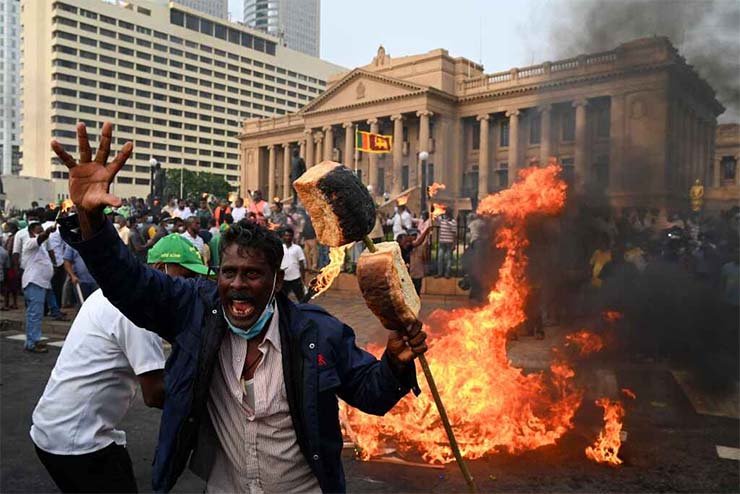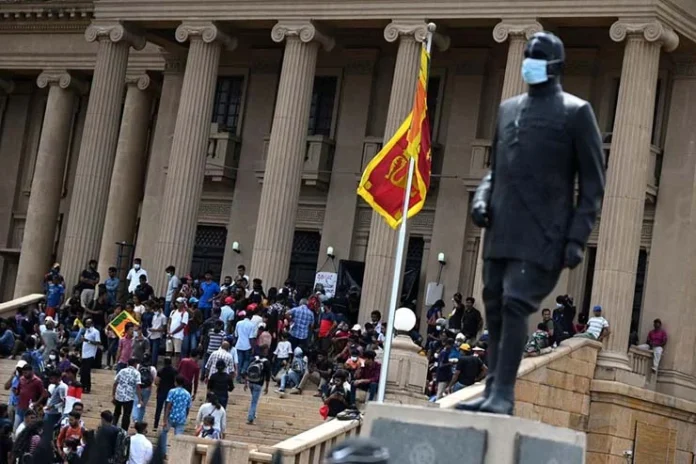Sri Lanka has been at the centre of a storm for the last few months. The situation has taken an ugly turn in recent days as the law and order situation and the economy have worsened leaving much to be worried about the future of the country. The latest news of Sri Lankan President Gotabaya Rajapaksa reportedly fleeing to the Maldives with the support of the air force has further aggravated the situation. Protesters blamed the Rajapakse Family and their coterie for the sorry state of Sri Lanka. This brings us back to a significant question. How did Sri Lanka end up in this dramatic situation and who is to be blamed for this?
The current situation – the effect
The looming crisis and public disenchantment due to a major economic downturn have thrown Sri Lanka into the path of disarray. A massive demonstration that shook Sri Lanka on July 9 finally compelled President Gotabaya Rajapaksa to agree to resign before the end of July. The dates for the same were escalated to a recent date given the renewed and surging protests. Prime Minister Ranil Wickremesinghe who took over from Mahida Rajapakse, the younger brother to Gotabaya, a month back had already resigned to pave way for an all-party government and asked the speaker of the lower house to handle the government as a caretaker till a new prime minister is elected.
With the speaker not agreeing to take over, Ranil was made the Caretaker Prime Minister yet again, which has been opposed by the opposition calling for a parliament session. Ranil has reiterated that the speaker has the right to choose a new caretaker PM and he is just discharging his duties to provide critical governance during these difficult days.
Though there have been sporadic protests against the government, which forced the President to impose a curfew in Sri Lanka, the major cause for the protest was the call for the resignation of the President and curtailment of the massive power that had been accumulated by the later among a chosen few.
Since the beginning of the economic instability wherein the foreign exchange reserves were severely dilapidated, Sri Lankans have grown increasingly discontented with the government, whom they blame for the economic woes in the country. There was a scarcity of petroleum products, food and essential items such as medicines, urea, and gas as well as basic consumer items including paper, oil and sugar. The anxiety among the common citizens led to angry protests in Colombo and major Lankan cities against the policies that brought Sri Lanka to this state. The angry and sometimes out-of-control violent protests forced the government to impose a curfew across Sri Lanka, but that did not help in soothing the anger of the population.
Video footage showing the President’s officials loading several black suitcases in a Sri Lankan navy ship before leaving for an undisclosed location added fuel to the fire
The lifting of the curfew in Sri Lanka only forced the protesters to reinstate their view that the corrupt politicians were to be blamed for the current situation that they are going through. The ‘Go Gotabaya’ call by the protesters was in this direction. The massive show of strength by the protesters with the tacit backing of leading faces of Sri Lanka, including Sanath Jayasurya, only strengthened the protest. Notably, the burning down of the Prime Minister’s private residence, the swarming of the Presidential building as well as the private residence of the President on Temple Street by protesters only reinforced the sorry plight Sri Lanka was in. Video footage showing the President’s officials loading several black suitcases in a Sri Lankan navy ship before leaving for an undisclosed location only added fuel to the existing fire.
It must be reminded that just a month back, Prime Minister Ranil Wickremesinghe said that the country’s economy had collapsed. The government’s negotiations with the International Monetary Fund have been complex because the country has now entered negotiations as a bankrupt state. Amid the pressure, several Think Tanks believe that India should intervene by sending its troops to restore peace and save the nation from anarchy, which was quickly rejected by the Indian foreign ministry.

Origin of the Crisis – the Cause
Several reasons could be attributed to the current volatile situation in Sri Lanka. To understand the cause, we need to look back to the decades-old conflict between the Sri Lankan government and the LTTE, which took a heavy toll on the lives of Tamils as well as the Sinhalese population. After years of war and the death of several presidents and prime ministers to suicide attacks perpetrated by LTTE, the woes of the Sri Lankan population were never-ending. With the advent of the Rajapakse government and its iron-handed approach, the LTTE soon became a part of history but at the cost of massive atrocities by the Lankan forces, which led the West to identify Rajapaksas as a war crime perpetrator.
The support came from China at the UN, which helped Rajapaksa to strengthen the foothold over the country while winning the hearts of the population. The next election gave another boost to the Rajapakse family, which proceeded forward with giving key positions to their kith and kins. The posts of the PM, President and Defence minister were all family-dominated and it looked as if Rajapaksa was the CEO of Sri Lanka as a company. Tied and untied loans and projects were freely awarded to Chinese government agencies as well as companies. Heavy Infrastructure projects were awarded to Chinese agencies without a cost-benefit analysis and at the cost of Sri Lankan taxpayers. Adding to that, the undue tax breaks rather than a sharp reduction in tax rates ostensibly to please the local population, keeping an eye on political ambitions wreaked havoc on the economy.
A surge in the crisis will force Sri Lankans to flee the nation and India will de facto end up at the receiving end of an exodus of migrants
The Chinese debt trap policy wreaked havoc on Sri Lanka. The latter was given easy loans for unsustainable projects. For example, the airport at Colombo, the seaport at Hambantota along with a recent loan of in the Sri Lankan port city of Colombo was the largest investment in the island nation’s history. Not too long ago, the takeover of the Hambantota port on a 99-year lease by China Merchant Port Holdings (CMPH) was another low in the history of Sri Lanka. The port is now operated ‘jointly’ by the Sri Lanka Ports Authority and CMPH, with the latter holding 80 per cent stake in the port and exercising near total control over its operations. On the contrary, China mentioned that those were self-inflected wounds behind the Sri Lankan Economic bankruptcy.
Given the low-risk appetite for high-value loans for Sri Lanka, it was getting clearer every passing day the consequence Sri Lanka would soon face. Rampant corruption broke the back of ordinary Sri Lankans and Sri Lanka slowly started edging towards bankruptcy. Covid-19 lockdowns and a prolonged Russia-Ukraine war affected the economy of Sri Lanka to the doorstep of bankruptcy. The downward spiral of the Tourism sector and the international trade of tea owing to Covid reduced the foreign exchange earned by Sri Lanka, drastically adding salt to the wound.
Lessons for India
The Sri Lankan Economic crisis is a double-edged sword for India. Being one of the neighbours of Sri Lanka, India cannot escape the effect of a country under distress. It has a moral and ethical responsibility to support the island nation, which it is already doing with a $4 billion commitment already made and routine medical, food, petroleum products and urea supply to fend off any crisis. But for how long?
The best solution is to follow a wait-and-watch policy and hope for Sri Lanka to stabilise. A peaceful and economically strong Sri Lanka is in the best interest of India
Any surge in the crisis will also force Sri Lankans to flee the island nation and India will de facto end up at the receiving end of an exodus of migrants fleeing an economically distressed nation. This indicates that Sri Lanka cannot be let down to slip into anarchy and India should ensure Sri Lankan governance is under full control of the situation. Does that indicate that India sends its forces to calm the situation and bring order? The comments made by Foreign Minister S Jaishankar effectively rule out any intervention by India in the times to come.
With India getting its fingers burned during the IPKF mission to Sri Lanka in 1987, India could not afford to take any immature decisions as in the past. The best solution would be to follow a wait-and-watch policy and hope for Sri Lanka to stabilise. The sooner that happens, the better it is for India. A peaceful strong and economically strong Sri Lanka is in the best interest of India.
-The writer is an Assistant Professor in Strategy and Entrepreneurship at Nirma University, Ahmedabad. A PhD from IIT Kharagpur, Dr saurabh writes on international geopolitics, and previously contributed articles and opinions to United States Naval Institute (USNI), Nikkei Asian Review and Taiwan Times. He can be connected at punit@nirmauni.ac.in. The views expressed are personal and do not necessarily carry views of Raksha Anirveda





